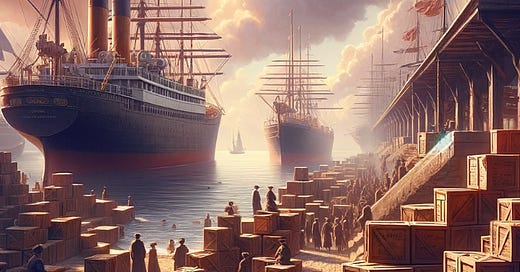Econ 115 :: The World Economy in the 20th Century :: Lecture 5 :: Post-1870 Globalization
The slides from the fifth lecture of my first post-big book excursion through the economic history of the 20th century;post-1870 globalizatiion...
The slides from the fifth lecture of my first post-big book excursion through the economic history of the 20th century;post-1870 globalizatiion…
2024-01-30 Tu: Globalization
DeLong, J. Bradford. 2022. Slouching Towards Utopia: An Economic History of the Twentieth Century. New York: Basic Books <bit.ly/3pP3Krk> <https://bcourses.berkeley.edu/files/87705514/download?download_frd=1>, ch. 1.
Eichengreen, Barry J. 1998. Globalizing Capital: A History of the International Monetary System. Princeton, NJ: Princeton University Press. <https://archive.org/details/globalizingcapit00eich_0>, ch. 2.
Lecture Highlights:
Courtesy of Sub-Turing BradBot: Today, we embark on a journey through the era of globalization that unfolded between 1870 and 1914, a period marked by profound economic transformations and the reshaping of societies around the globe.
The Emergence of Stage Theories: The concept of stage theories in human history traces its origins back to the 1700s, led by Scottish thinkers. They observed distinct modes of subsistence—ranging from hunter-gatherer societies to complex commercial and industrial economies—and speculated on the societal structures built upon these economic foundations. This intellectual pursuit laid the groundwork for understanding the evolutionary path of human societies, culminating in the industrial and technological advances of the 19th and 20th centuries.
The Malthusian Trap and Its Break: Historically, human societies were trapped in a Malthusian struggle, where any increase in resources would lead to a proportional increase in population, keeping standards of living relatively low. This cycle was eventually broken with the advent of the demographic transition, leading to a world where technological advancements significantly outpaced population growth, paving the way for unprecedented economic growth and a reconfiguration of societal norms.
The Demographic Transition: A critical component of this period was the demographic transition, a shift from high birth and death rates to lower ones, which played a crucial role in enabling sustained economic growth. This transition, coupled with technological advancements, facilitated a move towards a more stable and prosperous global population.
Globalization and the Doubling of Productive Capacity: The late 19th and early 20th centuries witnessed an acceleration in the rate of productivity growth, a phenomenon closely linked with the advent of globalization. The expansion of global trade networks, investment flows, and migration patterns fundamentally altered the economic landscape, contributing to a rapid increase in the world's productive capabilities.
Post-1870 Globalization in Trade: The era following 1870 heralded an unprecedented expansion in global trade, driven by advancements in transportation and communication technologies. The advent of iron-hulled steamships and the completion of major infrastructural projects, such as the Suez Canal, dramatically reduced shipping times and costs, making it feasible to trade goods across continents with previously unimaginable efficiency. This period saw a significant increase in the variety and volume of goods traded internationally, fostering economic interdependence among nations. The global trade network expanded, bringing distant markets into closer economic relation, and allowing for the rapid dissemination of goods, ideas, and innovations. This globalization of trade not only accelerated economic growth in industrialized nations but also brought about profound economic and social transformations in less developed countries, integrating them into a burgeoning global economy.
Post-1870 Globalization in Investment and Knowledge Transfer: Following 1870, the world witnessed a surge in cross-border investments, accompanied by a significant transfer of knowledge and industrial technologies. This era of investment globalization was characterized by the flow of capital from the industrialized centers of Europe and North America to the developing regions of Asia, Africa, and Latin America. Such investments were often directed towards the extraction of natural resources, the construction of infrastructure, and the establishment of manufacturing industries. Alongside capital, this period also saw the international transfer of technological and managerial expertise, which played a crucial role in shaping the economic landscapes of recipient countries. The spread of industrial technologies across borders facilitated the development of new industries in these regions, contributing to their economic modernization and integration into the global economic system. However, this process also led to complex economic dependencies and, in some cases, exacerbated inequalities between and within nations.
Post-1870 Globalization in Migration: The globalization of the late 19th and early 20th centuries was also marked by massive movements of people, with millions migrating across continents in search of better economic opportunities and living conditions. This unprecedented scale of migration was facilitated by the same technological advancements that spurred global trade and investment. Migrants from Europe, Asia, and other parts of the world moved to the Americas, Australia, and parts of Africa, contributing to the demographic reshaping of these regions. This movement of people not only altered the social and cultural landscapes of host countries but also had profound economic implications. Migrants provided the labor force necessary for the expanding economies of the New World, while also influencing the economic development of their home countries through remittances and the transfer of skills. The era's migration patterns laid the groundwork for the multicultural societies we see today, highlighting the interconnectedness of the global community.
The Gold Standard as Orchestrator of the System—as a Very Imperfect Orchestrator: The gold standard emerged as the foundational framework for international economic relations during this period, acting as the orchestrator of the global financial system. By pegging currencies to gold, countries sought to ensure stability and facilitate international trade and investment. The gold standard promoted a degree of monetary stability and predictability, which was crucial for the expansion of global economic activities. However, this system was far from perfect. It imposed rigid constraints on national economic policies, limiting countries' ability to respond to domestic economic challenges. The reliance on gold as a base for currency value also led to periodic liquidity crises, exacerbating economic downturns and contributing to social and political tensions. Moreover, the gold standard's mechanisms for correcting trade imbalances often resulted in deflationary pressures on economies, leading to unemployment and social unrest. Despite its role in facilitating the expansion of global trade and finance, the gold standard's inherent limitations underscored the complexities and vulnerabilities of the international economic system.
The Shift Towards the American Century: The early 20th century marked the beginning of the "American Century," with the United States emerging as a dominant economic and cultural force on the global stage. This shift was influenced by a combination of technological innovation, economic policy, and geopolitical developments.
Conclusion: As we reflect on the lessons of globalization from 1870 to 1914, it becomes evident that this period was a crucible for the modern world, shaping the economic, political, and social contours of the 20th century. The forces of globalization, technological progress, and demographic change forged a world that was interconnected in unprecedented ways, laying the groundwork for the challenges and opportunities that define the contemporary era.






